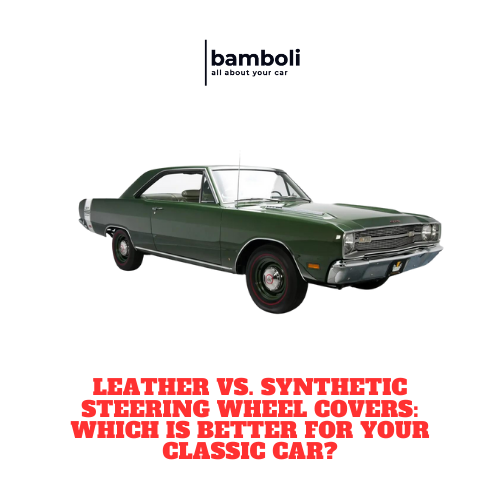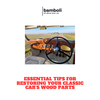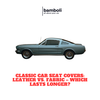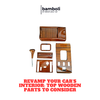Leather vs. Synthetic Steering Wheel Covers: Which is Better for Your Classic Car?

Leather vs. Synthetic Steering Wheel Covers: Which is Better for Your Classic Car?
Owning a classic car is a labor of love, with every detail contributing to its timeless charm. One such detail is the steering wheel cover, which can significantly enhance both the aesthetics and driving experience of your cherished vehicle. When it comes to selecting the perfect cover, the debate often narrows down to two options: leather and synthetic. Let's delve into the pros and cons of each to determine which is better for your classic car.
Understanding the Materials
Leather Steering Wheel Covers
Leather has long been associated with luxury and durability. Here’s a closer look at why leather might be the ideal choice for your classic car:
Pros:
- Aesthetic Appeal: Leather exudes a classic, sophisticated look that complements the vintage style of classic cars.
- Comfort: Leather covers provide a comfortable grip, especially in extreme temperatures where they remain cooler in summer and warmer in winter.
- Durability: High-quality leather is exceptionally durable and can withstand the wear and tear of daily driving.
Cons:
- Maintenance: Leather requires regular maintenance to keep it looking its best. It needs to be cleaned and conditioned to prevent it from drying out and cracking.
- Cost: Leather covers are generally more expensive than synthetic options, reflecting their premium quality.
Synthetic Steering Wheel Covers
Synthetic materials, including faux leather and other polymers, offer a modern alternative. Here’s why you might consider synthetic steering wheel covers:
Pros:
- Cost-Effective: Synthetic covers are usually more affordable than leather, making them an attractive option for budget-conscious classic car owners.
- Low Maintenance: Unlike leather, synthetic materials don’t require regular conditioning and are easier to clean.
- Variety: Synthetic covers come in a wider range of colors and textures, allowing for more customization.
Cons:
- Aesthetic Value: While many synthetic covers mimic the look of leather, they often lack the same level of sophistication and authenticity.
- Comfort: Synthetic materials may not provide the same level of comfort as leather, especially in varying temperatures.
Detailed Comparison: Leather vs. Synthetic
Durability
|
Aspect |
Leather |
Synthetic |
|
Longevity |
Long-lasting with proper care |
Durable but may wear out faster |
|
Maintenance |
Requires regular cleaning and conditioning |
Low maintenance; easy to clean |
Leather covers, with proper care, can last for many years, maintaining their appearance and feel. Synthetic covers are durable but might not have the same longevity as leather.
Comfort and Feel
|
Aspect |
Leather |
Synthetic |
|
Grip |
Soft, comfortable, and luxurious |
Can be less comfortable and smooth |
|
Temperature |
Cooler in summer, warmer in winter |
May get hot in summer and cold in winter |
Leather provides a naturally comfortable grip and adapts better to temperature changes, making it more comfortable year-round.
Aesthetics
|
Aspect |
Leather |
Synthetic |
|
Appearance |
Classic, luxurious look |
Wide variety of colors and textures |
|
Customization |
Limited to natural leather colors |
Highly customizable in appearance |
Leather’s classic appearance enhances the overall look of your classic car, while synthetic materials offer more customization options but may lack the authentic feel.
Installation Process
Hitch-Mounted Cargo Carriers: Installation of hitch-mounted cargo carriers typically involves sliding the carrier into the hitch receiver and securing it with a pin or lock. This process is straightforward, but the weight of the carrier can make it a two-person job.
Roof-Top Cargo Carriers: Installing a roof-top carrier often involves attaching it to roof racks with clamps or bolts. The process can be more cumbersome, especially on taller vehicles, and usually requires a ladder and additional hands.
Durability and Maintenance
Hitch-Mounted Cargo Carriers: Hitch-mounted carriers are usually made of robust materials like steel or aluminum, making them highly durable. Maintenance is minimal, often just requiring regular checks for rust or damage.
Roof-Top Cargo Carriers: Roof-top carriers, especially hard-shell ones, are also durable but can be more prone to weather-related wear. Soft bags need to be checked for tears and waterproofing integrity.
Real-World Use Cases
Scenario 1: Family Road Trips
For family road trips where you need to bring a lot of gear, a hitch-mounted carrier can be a lifesaver. The high load capacity means you can bring along everything from strollers to extra luggage without compromising space inside the vehicle.
Scenario 2: Solo Skiing Adventure
Hitch-Mounted Carrier: May not be the best choice as skis can be too long and cumbersome to secure properly. Also, it might limit access to the rear of the vehicle.
Roof-Top Carrier: Perfect for skis and snowboards, keeping wet gear out of the vehicle and maintaining interior space for personal belongings.
Pros and Cons Recap
Hitch-Mounted Cargo Carriers
Pros:
- Easy to load and unload
- Higher load capacity
- Does not affect vehicle aerodynamics significantly
Cons:
- Can obstruct rear visibility
- Might need additional lighting and license plate modifications
Roof-Top Cargo Carriers
Pros:
- Keeps rear of the vehicle clear
- Ideal for lighter, bulkier items
- Can be left mounted without major interference
Cons:
- More challenging to access
- Can reduce fuel efficiency due to increased wind resistance
Frequently Asked Questions
What makes leather covers more expensive? Leather covers are more expensive due to the cost of genuine leather and the craftsmanship involved in making them. The luxurious feel and durability also contribute to the higher price.
How often should I maintain a leather steering wheel cover? Leather steering wheel covers should be cleaned and conditioned every few months to prevent drying and cracking. Use products specifically designed for leather to maintain its quality.
Are synthetic covers eco-friendly? Synthetic covers can be more eco-friendly depending on the materials used. Some are made from recycled materials, though the environmental impact varies.
Which type of cover is easier to install? Both leather and synthetic covers can be easy to install, but synthetic covers might offer more flexibility due to the material’s properties. Always follow the manufacturer’s instructions for the best fit.
Can synthetic covers mimic the look of leather? Yes, many synthetic covers are designed to mimic the look and feel of leather. However, the quality and authenticity can vary between products.
Real-Life Scenarios
Scenario 1: Showcasing Your Classic Car
If your classic car is primarily for shows and occasional drives, a leather steering wheel cover might be the best choice. The luxurious look and feel of leather can enhance the car’s appeal and maintain its classic aesthetic.
Scenario 2: Daily Driving
For classic cars that are driven more frequently, a synthetic cover might be more practical. Its low maintenance and cost-effectiveness make it a suitable choice for daily use, providing durability without the need for constant upkeep.
Making the Right Choice
Choosing between leather and synthetic steering wheel covers ultimately depends on your priorities and how you use your classic car. Leather covers offer unmatched luxury, comfort, and durability, making them ideal for those who want to preserve the classic aesthetic. On the other hand, synthetic covers provide a cost-effective, low-maintenance alternative with more customization options. Consider your needs and preferences to make the best choice for your classic car.




